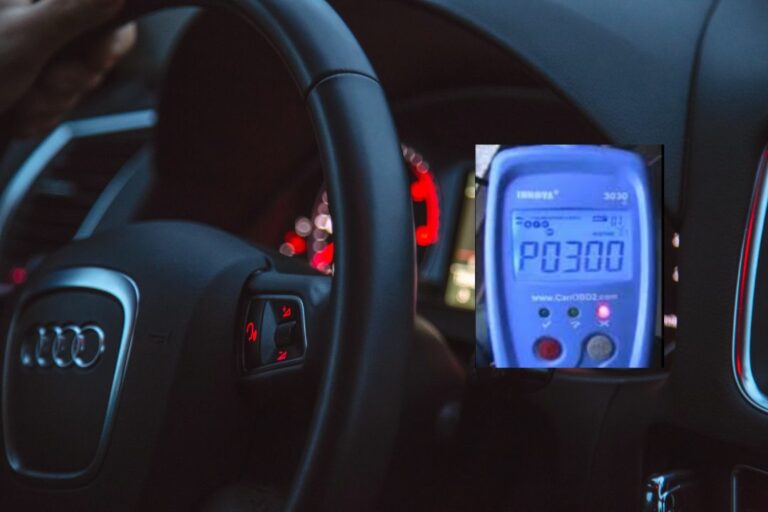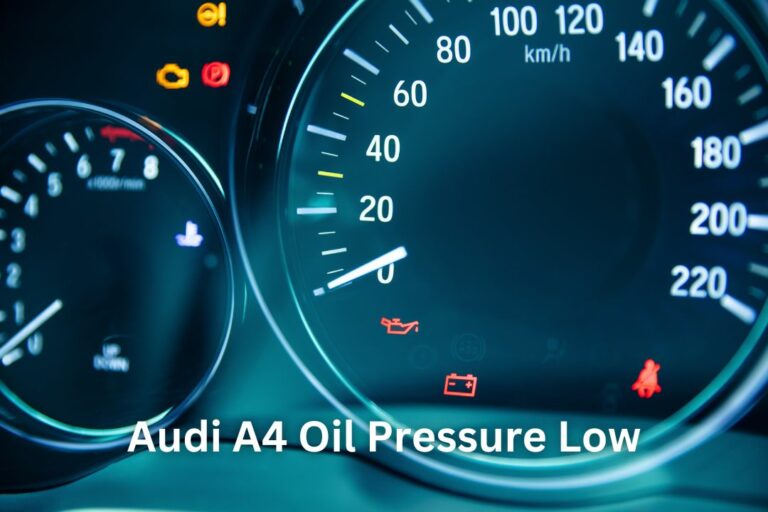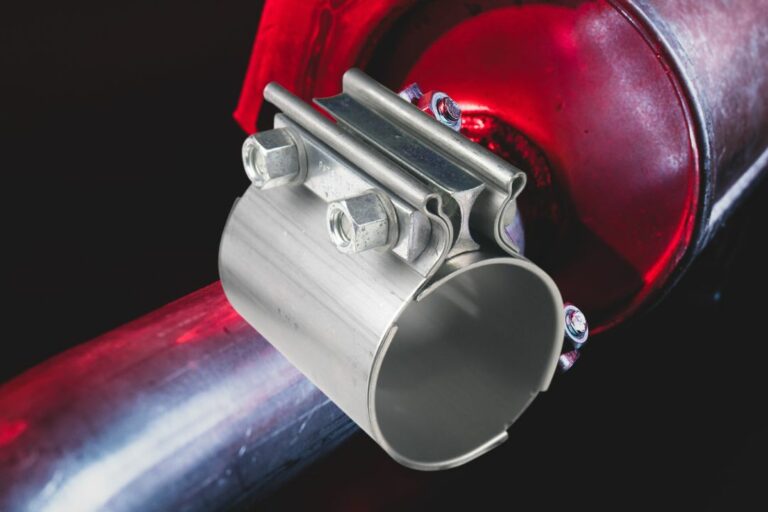P0299 Code Audi A4 Error (4 Issues 100% Guaranteed Fix!)

You’re driving on the highway, enjoying the power of your Audi A4 turbocharged engine when suddenly you feel a loss of power and hear some hissing or rattling noises from under the hood.
Just as quickly, your check engine light comes on – it’s not what you were hoping for!
Don’t panic just yet – this could be an underboost condition triggering a P0299 code in your ECU.
It means that there is an issue with the boost pressure regulation system, which includes various components such as turbocharger/supercharger, charge piping, diverter valve and more.
While this problem may sound like a headache to diagnose and fix, we’ve got you covered with all the information you need to know about P0299 code in Audi A4 engines.
In this article, we’ll discuss common causes of P0299 Code Audi A4 in detail along with their symptoms so that if it ever happens to you again (hopefully not!), at least now you will have an idea where to start looking for solutions.
When a car throws a P0299 code, its most noticeable symptom is a loss of power. The turbocharger or supercharger isn’t able to produce the boost pressure demanded by the ECU. This means the vehicle will perform slower than usual and feel sluggish.
What is the P0299 Code?
The P0299 code is a diagnostic trouble code that indicates a turbocharger or supercharger underboost condition.
This code is specific to Audi A4 engines and is triggered when the ECU detects that the boost pressure is lower than the expected value.
The check engine light will come on, and the engine may go into limp mode, reducing power and performance to protect the engine from damage.
Symptoms of the P0299 Code:
If your Audi A4’s ECU detects an underboost condition, you may experience a number of symptoms associated with the P0299 code.
These can include loss of power and acceleration, an engine that takes longer to spool up or produce power, whining or hissing noises from the turbocharger or wastegate, rattling sounds coming from the engine bay, and most commonly- the check engine light will be illuminated on your dashboard.
If you notice any of these symptoms while driving your vehicle, it is important to have it inspected by a qualified member as soon as possible to avoid potential damage to other components in the system.
Ignoring these signs could result in serious engine problems down the line resulting in costly repairs.
Causes of the P0299 Code:
The P0299 code can be triggered due to a range of hardware or software related issues that prevent the engine from achieving its target boost level. Here are some common causes that you should check for:
| Cause | Description |
|---|---|
| Turbocharger/Supercharger Underboost | The P0299 code often indicates a turbocharger or supercharger underboost condition. This can occur due to issues such as a malfunctioning wastegate, a leaking boost pipe, or a faulty turbocharger/supercharger. |
| Boost Pressure Sensor Malfunction | A faulty boost pressure sensor can send incorrect signals to the engine control module (ECM), resulting in an underboost condition and triggering the P0299 code. |
| Intake/Exhaust System Restrictions | Blockages or restrictions in the intake or exhaust system, such as a clogged air filter, a damaged intercooler, or a restricted catalytic converter, can impede the flow of air and cause an underboost condition. |
| Vacuum Leak | A vacuum leak in the intake system, such as a loose or damaged vacuum hose, can disrupt the proper functioning of the turbocharger, leading to underboost and the P0299 code. |
| Faulty Diverter Valve | The diverter valve, also known as a blow-off valve or bypass valve, redirects excess boost pressure. A malfunctioning or stuck diverter valve can cause underboost and trigger the P0299 code. |
| ECM Software Update/Reflash Required | In some cases, the P0299 code may be triggered due to outdated or incompatible engine control module (ECM) software. Updating or reflashing the ECM may resolve the issue. |
| Wiring or Electrical Connection Issues | Faulty wiring, loose connections, or electrical problems related to the boost pressure sensor or turbocharger system can cause the P0299 error code to appear. |
- Boost pressure regulation valve: This component controls the opening and closing of the wastegate on the turbocharger, in order to regulate boost pressure. If this valve fails, it can cause underboost condition.
- Leaks in charge piping: Any leaks in the charge piping between the turbo/supercharger and intercooler or throttle body can disrupt boost levels and trigger this code.
- Faulty diverter valve/recirculation valve: Failure of these valves can also lead to problems with maintaining proper boost levels.
- Failed turbocharger or supercharger: A failed source of pressurized air, such as a faulty turbocharger or supercharger unit, will prevent your engine from generating sufficient power.
It’s important to note that failing to address any issues causing an underboost condition could quickly lead to more serious mechanical failures within your vehicle. So if you suspect there is a problem, take action immediately by performing necessary diagnostics and repairs.
How to Diagnose the P0299 Code in Your Audi A4?
If you suspect that your Audi A4 is displaying the P0299 code, it’s important to diagnose the root cause of the issue promptly. Here are some steps that a mechanic may take:
Step 1: Check for Vacuum Leaks:
The first step in diagnosing the P0299 code is to check for any vacuum leaks. A vacuum leak can cause a variety of issues, including an underboost condition that triggers this code.
Some components related to the intake system, such as charge piping or valves like the diverter valve, could be faulty and causing pressure loss. Other possibilities include faults with control systems like the throttle position sensor and EGR valve.
To check for vacuum leaks, you can use a smoke machine or propane torch to detect any air escaping from connections or hoses within the subsystem.
Carefully inspect all tubing and hoses connected between various engine components. If a leak is found in one of these areas, it needs to be repaired immediately before going forward with further diagnosis.
Step 2: Check the Turbocharger and Boost Pressure:
The turbocharger is a critical component that plays a significant role in the engine’s performance.
One of the main causes of the P0299 code is an issue with the boost pressure, which can be affected by a faulty turbocharger.
To check if your Audi A4’s turbocharger is functioning correctly, start by visually inspecting it for any visible signs of damage or wear.
Look for cracks or leaks in the exhaust and intake system and check to make sure all hoses are properly connected.
Next, you’ll want to measure the boost pressure using a scan tool or pressure gauge. Compare your readings with manufacturer specifications to determine if there are any issues with underboost.
If you find that your boost pressure is low, this could indicate that there’s an issue with your wastegate or wastegate actuator.
If this is the case, you will need to replace these components as they control how much exhaust gas flows into the turbine wheel, which ultimately affects how fast it spins and generates boost.
In addition to checking for faults in your system control subsystems such as throttle controls or charge air coolers can help ensure that everything is running efficiently.
Step 3: Inspect the Charge Air Cooler:
Inspect charge air cooler (intercooler) for airflow blockages, frosting, or oil contaminations & make sure it is performing within specification.
Step 4: Check the Mass Airflow Sensor (MAF):
The Mass Airflow Sensor (MAF) plays a crucial role in the operation of your Audi A4’s engine. It measures the amount of air entering the engine, which allows the engine control module to adjust fuel delivery accordingly.
A fault in this component can lead to several issues, including an underboost condition that triggers the P0299 code. If you suspect that your MAF is causing problems, then it’s important to check it as part of your troubleshooting process.
To do so:
- Disconnect the MAF from its electrical connector and remove it from its housing.
- Inspect the sensor for any signs of damage or wear such as cracks on rings or sensors due to contamination by dirt and/or oil.
- Clean the sensor with an appropriate cleaner and allow it to dry completely before reinstalling it into place.
- After reinstallation, clear any codes that may have been triggered by a malfunctioning MAF with a scan tool.
If cleaning doesn’t solve your problem, then replacing a faulty MAF could be necessary for resolving issues associated with P0299 code triggering conditions in your vehicle’s turbocharged system.
Keep in mind that failure or improper functioning of other components like wastegate valve, boost pressure sensor/charge pressure sensor, or diverter valve can also cause similar symptoms leading up-to p0299 related troubles – So make sure these are inspected too if needed!
Step 5: Inspect the Exhaust Gas Recirculation (EGR) Valve:
If EGR valve is full of carbon deposits then it should be replaced immediately as this can cause reduction in engine efficiency resulting in underboost conditions.
How to Fix the P0299 Code in Your Audi A4?
Step 1: Address Any Vacuum Leaks:
The first step in diagnosing and fixing the P0299 code is to check for any vacuum leaks in the engine system. Common causes of vacuum leaks include faulty intake manifold gaskets, broken or cracked vacuum hoses, and worn-out throttle body components.
Vacuum leaks can cause issues with engine performance, such as loss of power and acceleration. They can also affect the boost pressure readings, triggering the P0299 code.
To identify a vacuum leak, you may need to perform a smoke test or use a diagnostic tool that measures pressure levels in different subsystems of the engine.
Once you have located the source of any vacuum leaks, replace or repair the faulty component as needed.
Remember to reset your vehicle’s ECU after addressing any issues with vacuum leaks and clearing codes from previous faults found during diagnosis.
Step 2: Clean or Replace the Turbocharger:
If the root cause of the P0299 code is a faulty turbocharger, then you will need to clean or replace it as necessary.
Start by inspecting the turbocharger for any visible signs of damage or wear, such as cracks or leaks in the exhaust or intake system.
Next, measure the boost pressure using a scan tool or pressure gauge and compare your readings with manufacturer specifications.
If the boost pressure is low, then there may be an issue with the wastegate or wastegate actuator, which controls how much exhaust gas flows into the turbine wheel.
If cleaning the turbocharger does not resolve the issue, then replacing it may be necessary. Make sure to use a genuine Audi A4 Turbocharger.
Step 3: Replace the Charge Air Cooler:
If step two didn’t fix the problem, and you’re still getting the P0299 code after checking your turbocharger and boost pressure, it may be time to inspect your charge air cooler.
The charge air cooler (CAC) is an essential component of the turbocharging system that cools down the compressed air before it enters the engine.
A faulty or damaged CAC can lead to a decrease in engine power and poor fuel economy, which could cause underboost conditions and trigger the P0299 code.
Some signs of a damaged or failing CAC include oil leaks, coolant leaks, bent fins on the intercooler core, or physical damage.
Replacing a faulty charge air cooler is typically recommended if it’s found to be causing an underboost condition on your Audi A4. You can find replacement parts from reputable manufacturers or dealerships that will fit perfectly into your vehicle’s subsystem without needing any special coding or revision.
It’s important to note that properly diagnosing an underboost issue with your Audi A4 requires expertise in understanding all components of its turbocharging system such as valves, rings, sensors etc.
If you are not comfortable performing these checks yourself then seek out assistance from a certified mechanic.
Step 4: Clean or Replace the Mass Airflow Sensor (MAF):
Step 4 of diagnosing and fixing the P0299 code in your Audi A4 involves checking the Mass Airflow Sensor (MAF).
The MAF is a critical component in controlling the amount of air that enters the engine and works closely with other subsystems like boost control, throttle control, and exhaust gas recirculation.
Faulty readings from this sensor can cause an underboost condition or make it difficult for your engine to reach its target boost level.
If you suspect that your MAF may be dirty or damaged, you could try cleaning it first by using a specialized cleaner spray.
However, if replacing it seems like a better option due to excessive wear and tear or damage beyond repair, then get yourself a new one as replacement.
Step 5: Replace the Exhaust Gas Recirculation (EGR) Valve:
If none of the previous steps have resolved the underboost issue and you are still getting the P0299 code, it may be time to replace your Exhaust Gas Recirculation (EGR) valve.
The EGR valve is responsible for recirculating a portion of the exhaust gases back into the engine to reduce emissions. However, if it becomes stuck or clogged with carbon buildup, it can cause an underboost condition and trigger the P0299 code.
Replacing the EGR valve will require some mechanical knowledge and skill or you could bring your Audi A4 to a trusted mechanic or service center member.
They will need to remove parts of your intake and exhaust systems in order to access and replace this component in question
When replacing any components, make sure they are OEM parts from certified sources. Using cheap aftermarket parts could lead to other issues down the line.
Once replaced clear any codes stored in memory by resetting control module To go through adaptation process throttle member coding & charge pressure actuator reset (only if necessary).
Preventing the P0299 Code in Your Audi A4:
Regular Maintenance:
Regular maintenance is crucial in preventing the P0299 code from occurring in your Audi A4.
It’s important to regularly inspect and maintain all turbocharger system components, including the wastegate, boost pressure sensor, and diverter valve.
Additionally, regular inspection of the charge air cooler and exhaust gas recirculation valve can help detect any issues before they become a big problem.
Ensuring that all vacuum lines are properly connected and free of leaks can also prevent an underboost condition from occurring.
Regularly checking the throttle control subsystem as well as the intake system for any faults or issues can help avoid potential problems down the line.
Use of High-Quality Parts and Fluids:
When it comes to preventing the P0299 code in your Audi A4, using high-quality parts and fluids is crucial.
Cheap or low-quality parts may not last as long or perform as well as their more expensive counterparts, which can lead to component failure and trigger the P0299 code.
Investing in high-quality components from reputable brands can help ensure that your vehicle runs reliably and efficiently, minimizing the risk of boost pressure issues.
Additionally, using the recommended fluids for your Audi A4’s engine and turbocharger system can help maintain proper lubrication and reduce wear on critical components like the turbocharger bearings and piston rings.
Conclusion
The P0299 code in an Audi A4 can be caused by a range of hardware or software related issues that prevent the engine from achieving its target boost level.
Ignoring signs of an underboost condition could result in serious engine problems down the line resulting in costly repairs.
To diagnose and fix the P0299 code, a mechanic may check for vacuum leaks, inspect the turbocharger and boost pressure, inspect the charge air cooler, check the Mass Airflow Sensor (MAF), and inspect the Exhaust Gas Recirculation (EGR) Valve.
Regular maintenance and use of high-quality parts and fluids can help prevent the P0299 code from occurring.






